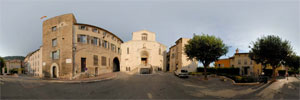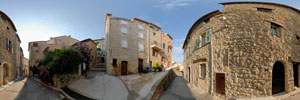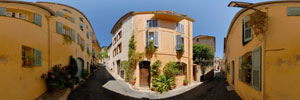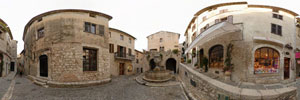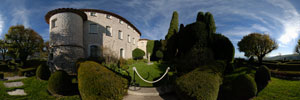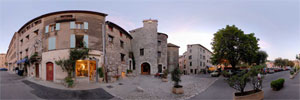Nice Panorama
- News :
- French Riviera :
- Provence :
- Var :
- Leisure :
- Economy :
- Gastronomy :
- Sport :
- Accommodation :
- Tourism :
- Site Map :
Grasse’s region on the French Riviera : a virtual visit
Grasse
is a lovely city to visit. You can, while you stroll through the old town and its narrow streets, visit its many museums. So let us quote the International Perfume Museum, the Museum of Art and History of the Provence and the Villa Museum Jean-Honoré Fragonard.
Through an exceptional nature (jasmine, rose, lavender, orange blossom, tuberose), Grasse became the city of perfume. It thus appears as the essential place to be for any perfumer in the internationally-acclaimed bestseller “Perfume: The Story of a Murderer” by Patrick Suskind. You can also discover the manufacturing secrets by visiting ancient local factories (Fragonard, Molinard and Galimard).
Chateauneuf-de-Grasse
is a village listed in the inventory of historic sites in the Alpes-Maritimes. Built on a hill 417 m above sea level, the village is overlooking the plain of Opio and offers a beautiful view up the bay of Cannes and the Esterel Massif
The visit of the village allows observing, among other, some buildings of the XVI century, the church of St Martin build in the XVII century, and some vestiges of the old Castle (fortifications, ramparts and tower). The large building of the XVII century near the main square is called “the castle” because it is built on the ruins of the old Castle. It was a Seigneurial property. Finally, not far from Chateauneuf, one can discover the Notre Dame of Brusc chapel which is the remnant of a vast basilica, built in the XI century.
Le Bar-sur-Loup
is a medieval village located in the hinterland of Grasse. It deserves a visit not only for its panoramic views of Gourdon, the Gorges and the Valley of Loup but also for its very ancient houses, squeezed against each other around the Castle and the Church and its old streets where one can circulate only on foot.
The parochial church of St Jacques le Majeur is a monument of Roman and Gothic styles, which construction occurred between the XIIIth and the XVth century. It houses an altarpiece of late XVth century by the painter Louis Brea, which lived in Nice, and “Dance of Death”, painting on wood of the XVth.
A legend explains that the Count of Bar having given a ball in the middle of Lent, the guests fell dead. The “Dance of Death” was painted to commemorate the Divine punishment. It shows the Death, equipped as an archer, which kill the dancers with arrows. The souls out of the mouths of corpses, in the form of small naked figures, are weighed in the balance held by St. Michael, at the feet of Christ, and are precipitated into the jaws of a monster who represents the entrance to Hell.
The castle of Bar sur Loup also saw in 1722 the birth of Francois-Joseph Paul, Count of Grasse. This one became famous, at the behest of Louis XVI, as a lieutenant general of the naval forces. He went to the rescue of American fighting against the British for their independence and played an important role in the Battle of Yorktown bringing in 3000 men to support Washington, Lafayette and Rochambeau and resisting an English fleet to resupply the fort of Yorktown.
In the last century, Celestin Freinet was the pride of Bar sur Loup for its educational pedagogy that he began in the village from years 1920 to 1930 and then later in the village of St. Paul de Vence.
Saint-Paul de Vence
has preserved behind it's ramparts raised on order of François Ier, the aspect of a feudal city guard of the ancient border of the Var.
Numerous artists and writers frequented the village and the Auberge de la "Colombe d'or", among whom Matisse, Modigliani, Chagall, Jean Giono, Jacques Prévert, Yves Montand and Simone Signoret.
Saint-Paul de Vence is a very frequented place for it's very numerous art galleries and for the Foundation Maeght, museum dedicated to the modern and contemporary art. The Foundation is situated in a garden decorated with numerous outdoors sculptures and welcome every year more than 200 000 guests. It exhibits works of Joan Miro and Alberto Giacometti. The summer, the permanent collection leaves the place to temporary exhibitions.
Gourdon
is one of the three villages classified as “The most beautiful villages of France” (by the association which aims to promote assets of small and picturesque French villages of quality heritage) located in the country subdivision of the Alpes-Maritimes. Located near the plateau of Gréolières and the Gorge of the Loup (river canyon), Gourdon is an ideal village to finish beautiful days spent outdoor in the fresh air (biking, hiking, paragliding).
The village has many artisans showcasing local products, including perfumes and honey from many flowers found on the plateau. The village has a special creative perfumery and toiletries, soaps and scented candles: “La Source Parfumée” and “Allongue Perfume”. The village has also manufacturers of confectionery and gingerbread (cake made with honey): “La Marquisette”, “La Maison du Miel Bon”. The village is also home to many artists: hand glass makers, silk creations and natural stones jewellery.
If you visit Gourdon, take time to discover the castle which houses two magnificent museums (The Museum of History and the Museum of Decorative Arts and Modernity) and the Gardens with different styles: terrace with French formal garden (also called “jardin à la française”) created by the landscape architect André Le Nôtre who also designed the Gardens of Versailles for Louis XIV, the terrace with Italian garden, the medieval garden and the Provencal garden.
Tourrettes-sur-Loup
is a village situated on a rocky spur easy to defend because situated on a plateau falling sheer. The village is strengthened by the outside houses which form a wall. Its alleys shelter the workshops of ceramists, painters, sculptors, leather workers and weavers.
Tourrettes-sur-Loup is the capital of the violet because it is the only village in France where this flower is cultivated as unique or main culture. In autumn and winters, flowers are picked to form bouquet of 25 surrounded with some leaves. In spring, when the bloom is plentiful, the flower is picked without the stalk for the confectionery. In summer, the leaf is mown to be transformed the same day in concrete then in absolute in the factories of Grasse. It enters in the composition of numerous perfume. The season is enclosed by the Holiday of Violets, which takes place according to the bloom, on 1st or 2nd Sunday of March.
Around Monaco
Around Nice
Around Cannes
Around Grasse
